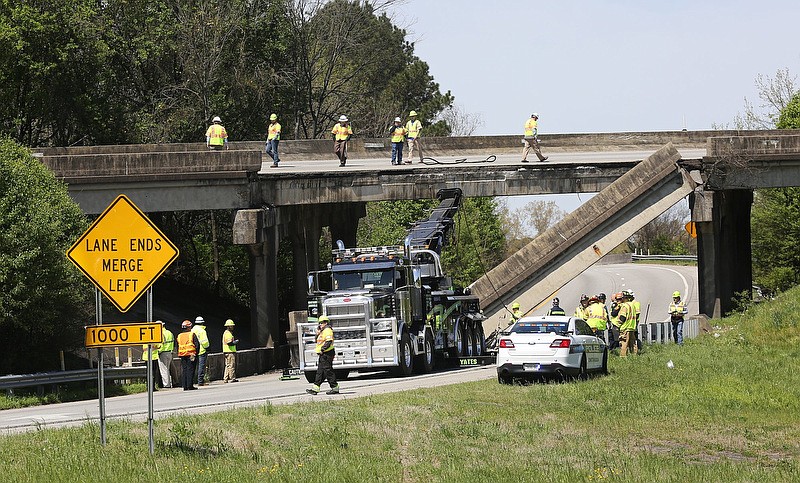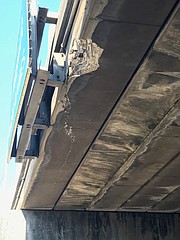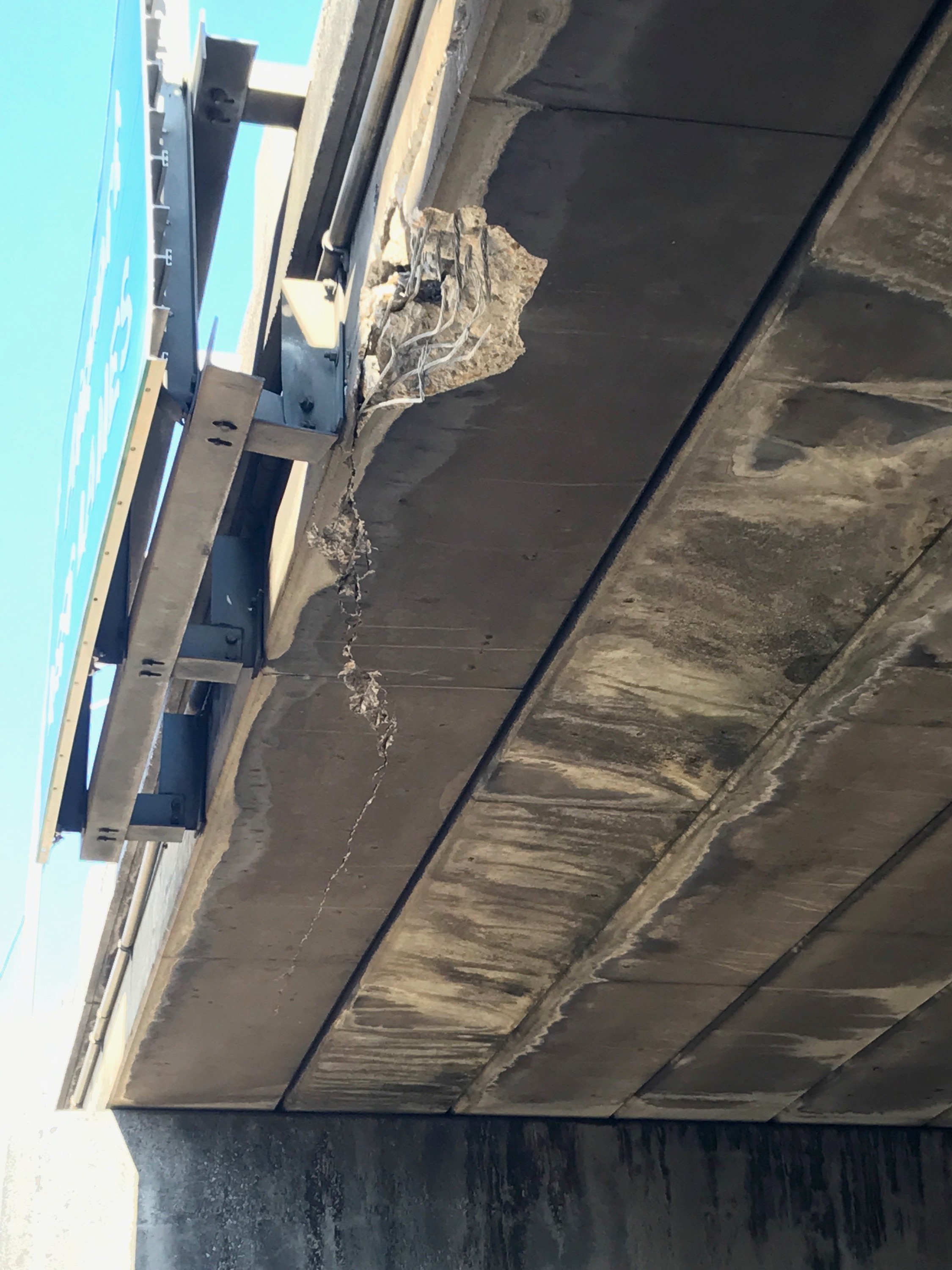Oversized big rigs in less than a year have been blamed for two major collisions with Chattanooga area interstate bridges that forced emergency repairs and backed up traffic for hours.
The most recent incident happened last Tuesday, leading to an epic backup and overnight repairs to remove a damaged concrete beam and stabilize the structure. And it's only been nine months since an incident April 1, 2019, when a piece of railing fell from the Interstate 75 South overpass ramp and a car on the Interstate 24 West ramp hit it, injuring the driver.
Both incidents were blamed on over-height tractor-trailers, though the vehicle involved last April was never confirmed or found.
The Tennessee Department of Transportation doesn't keep a specific tally of such collisions, usually dubbed "bridge strikes," or cost figures on emergency repairs, but agency spokeswoman Jennifer Flynn said Thursday those types of accidents are not unusual and are expensive, dangerous and inconvenient.
"On average, there are at least a dozen bridge strikes in Tennessee each year, sometimes more," Flynn said. "Depending on circumstances, repair costs can run as much as a million dollars."
Flynn said an example of a million-dollar repair was the April 27, 2018, bridge strike in Nashville caused by an oversized load on a truck that was more than 100 miles off its permitted route. The truck hit a steel bridge on Interstate 40 at Interstate 65, and the impact was so severe the truck couldn't be moved until the bridge beam was cut away from the structure, which took 16 hours, she said.
"I've never seen damage that bad in 30 years," TDOT structures division director Ted Kniazewycz told stateline.org in December of the Nashville bridge strike. Stateline is an initiative of The Pew Charitable Trusts.
"Bridge strikes are potentially catastrophic," trade group American Trucking Associations Vice President Darrin Roth told Stateline. "There have been bridges that have been brought down or severely damaged to the point they have to be replaced."
National Highway Traffic Safety Administration records show that, nationwide, there's a human cost, too.
"Over the last 5 years (2014-2018) there were 12 fatal crashes where a large truck struck a bridge overhead structure," administration spokesman Derrell Lyles said in an email. "Thirteen fatalities occurred in those crashes."
REGION BRIDGE FACTS
Interstate overpass heights in the southern end of the Tennessee Department of Transportation’s 24-county Region 2 range from a minimum of 14 feet, 10 inches to a maximum of 73 feet, 6 inches for trucks traveling Interstate-75 and Interstate-24.REGIONWIDETotal I-75: 27 overpasses | min. 15 feet, 6 inches, max. 20 feetTotal I-24: 49 overpasses | min. 14 feet, 10 inches, max. 73 feet, 6 inchesSEVEN REGION COUNTIESBradley I-75: 3 overpasses | min. 15 feet, 8 inches, max. 16 feet, 5 inchesCoffee I-24: 15 overpasses | min. 16 feet, max. 17 feet, 10 inchesGrundy I-24: 3 overpasses | min. 14 feet, 10 inches, max. 16 feet, 3 inchesHamilton I-24: 14 overpasses | min. 15 feet, 6 inches, max. 40 feetHamilton I-75: 12 overpasses | min. 15 feet, 6 inches, max. 20 feetMarion I-24: 17 overpasses | min. 15 feet, 10 inches, max. 73 feet, 6 inchesMcMinn I-75: 12 overpasses | min. 15 feet, 9 inches, max. 17 feet*Note: Interstate bridges that traffic does not pass under are not included in this listSource: Tennessee Department of Transportation
A BRIDGE TOO LOW
A bridge strike similar to the one on Moore Road happened Sept. 18, 2008, at the I-24 bridge over U.S. Highway 72 in Kimball, Tennessee.
That bridge, built in 1965, was damaged by a big rig hauling a too-tall trackhoe on U.S. 72 that struck the westbound side of the interstate bridge, severely damaging several beams and triggering the launch of a $13.5 million project already planned for raising the interstate's spans to 16 feet, 8 inches to allow more clearance for big trucks. State and local officials said the original bridge with a clearance height of 14 feet, 7 inches had been hit repeatedly over the years by trucks hauling oversized equipment and improperly loaded logs.
Last July in Bradley County, a big rig crashed into the middle support columns of the Harrison Pike overpass on I-75 and burst into flames, forcing temporary road closures and inspection of the structure. Sometimes bridge strikes come from other human-operated vehicles such as the barge that hit I-75's Hiwassee River bridge at the Bradley-McMinn county line during a heavy storm in 2017.
Tennessee Highway Patrol officials last week said "there's no excuse" for the big rig's load striking the Moore Road overpass Tuesday afternoon.
Officials noted there was evidence that the Belvoir Road overpass had also been struck by something but it was deemed safe.
Highway Patrol spokesman Lt. John Harmon said at a news conference last week that most local bridge strikes involve local companies moving equipment from job site to job site. Although there's no official number on similar incidents, "it's happening too frequently" in the area, Harmon said.
The maximum height of a load is set at 13 feet, 6 inches, and a maximum width is set at 8 feet, according to the THP. Anything over that requires a Tennessee Department of Transportation permit.
Officials said the driver of the truck that struck the Moore Road bridge did not have a permit, and wasn't required to have one, but was cited for being over the height limit because the trackhoe it was hauling was improperly loaded.
TDOT issued 133,356 single-trip permits last year, as well as 6,407 annual permits in 2019, Flynn said.
The state seeks reimbursement for damage to public property and roadway structures when it knows who's responsible.
"Otherwise, it's the taxpayers who pay for it," Flynn said. The insurance adjuster for the owner of the truck involved in the Moore Road bridge strike was at the scene Tuesday night.
Bridge strikes "are comparatively infrequent, but when they do happen, damages usually run into the six-figure territory," Flynn said. "When amicable, full reimbursements don't happen, whether for reason of policy limits or disputed charges, we refer the matter to the attorney general's office."
Flynn said sometimes it's an interstate backup that creates problems elsewhere when traffic scrambles to find a way around the snag. That's what happened Tuesday in East Ridge, she said, and the Chattanooga area's geography makes detours tough.
When authorities closed I-24 East last Tuesday at Moore Road and blocked off South Terrace at Belvoir, traffic trying to dodge the closure on I-24 East jumped off at the Germantown exit and found gridlocked traffic extending onto side streets in East Ridge and Brainerd.
Big rigs and all kinds of other vehicles were seen on neighborhood streets, backed up a dozen deep at some intersections.
That causes strike problems, too, Flynn said, noting that truckers in backups on I-24 East sometimes try to detour through the Bachman Tubes tunnel into East Ridge, where the clearance height is 12 feet, 6 inches. The McCallie Tunnel in Brainerd is a tight 13 feet, 8 inches, but passable by trucks with normal loads.
AGING INFRASTRUCTURE
Meanwhile, Tennessee's bridges are aging and many need work.
There are 19,822 structures in Tennessee that meet the standard definition of a public highway bridge, not including the approximately 400 bridges owned and operated by other agencies, according to TDOT.
Among the 8,367 Tennessee bridges maintained by the state, 219 are considered to be structurally deficient, TDOT records show.
The highest bridge in the Chattanooga region at more than 73 feet is the CSX railroad bridge on I-24 in Marion County near the Whiteside community, according to TDOT.
TDOT officials said the new standard minimum height for new bridge construction is 16 feet, 6 inches. In the past, the standard height was 14 feet, 6 inches, which remains the cut-off height for posting a warning sign - any bridge clearance lower than 14-and-a-half feet must be posted. The legal load height is 13 feet, 6 inches, according to TDOT.
The state's current $132.5 million improvement project at the I-75/I-24 interchange known as the "Split" includes replacement of the Moore Road and Belvoir Road overpasses. Contractors already have started replacing the Spring Creek Road overpasses, and the McBrien Road overpass is also slated for replacement along with I-24's bridges over Germantown Road, Flynn said.
Flynn said TDOT and the THP urge drivers to report incidents involving over-height or over-width loads when they see them to help officials respond quickly and potentially reduce dangers.
Contact Ben Benton at bbenton@timesfreepress.com or 423-757-6569. Follow him on Twitter @BenBenton or at www.facebook.com/benbenton1.


